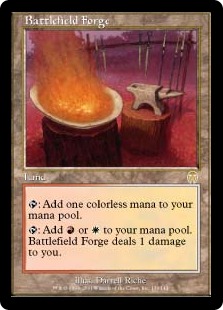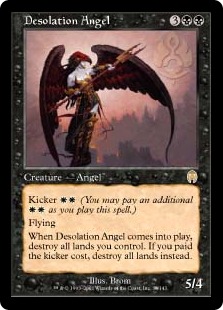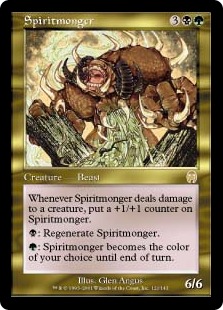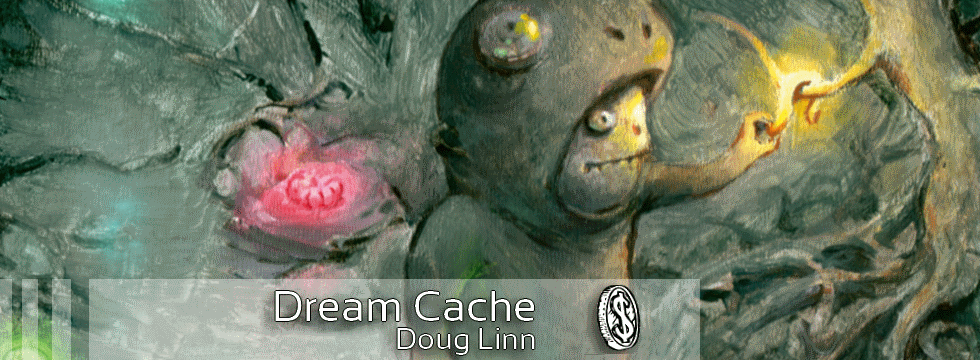Are you a Quiet Speculation member?
If not, now is a perfect time to join up! Our powerful tools, breaking-news analysis, and exclusive Discord channel will make sure you stay up to date and ahead of the curve.
Apocalypse was our first taste of enemy-color cards, and those combinations often can bring out incredible results. What one color is poor at, its enemy might be superb at. Thus, you end up with fun cards like Illuminate, Fire/Ice and Prophetic Bolt. Want to build monoblue control, but also interested in some creature removal that doesn't suck? Those three cards gave casual players a taste of going over to the enemy's side, and there were plenty like it. Apocalypse also spawned legions of greedster deck builders who wanted to play Spiritmonger and Absorb in the same deck, because they finally had the painlands to support it. They never really panned out (you need Vivid lands and Reflecting Pool for that stupidity!) but it was fun to “splash” Fact or Fiction in your G/B deck. Let's look at what held up to the test of time!

This includes all the enemy-color painlands, since they're all around the same price.
These cards were revolutionary because they didn't completely suck. To give you an example of what a little bit of time did for design quality, compare Salt Flats to Caves of Koilos. Salt Flats comes in tapped and still eats some pain! We lack enemy taplands, though the tri-lands like Arcane Sanctum can work decently. These lands are, with the enemy filter lands like Flooded Grove, the go-to mana producers for many decks angling to gram Red and White alongside each other, or support Green and Black. They've been reprinted a little bit, but people hold out for, and pay a premium for, the black-bordered versions.
As an aside, it's interesting how much painlands have dropped in price. For years, they were a solid fiver. That's because, aside from dual lands, you could only play absolute trash cards for mana fixing. Timberline Ridge bad. If painlands were evergreen base set cards, they'd still be worth something. However, R&D realized that new players hate to pay life for mana, even if it's something good like City of Brass. Thus, we got a new line of shocklands, filter lands, and whatever we call M11 lands. Many times, those cards were as good as, or better than, the painlands, and casual players bought them instead. Even EDH doesn't sustain painlands! For example, in a Bant deck, I would have to get through duals, shocklands, filter lands, fetchlands and cards like City of Brass and Seaside Citadel before I considered the painlands. With utility lands, I hit 40 before I dipped into painlands. In 5-color EDH decks, you've got all the duals, all the fetches and all the filters before you stare at something that will actually ping you when you tap it. The end result is that there's not even much of a casual market for these guys.
$1.50 - $2.50
From the makers of Morphling... Cromat is a punisher, but he requires a lot of mana commitment to make it work. I suspect that most of the people who buy them put them to use as their General in EDH, which is what I do. Because of this, the normal version is worth nothing, while the foil version is worth “something.”
$1.00 ($12.00 in foil)

This week, Tom Lapille wrote about what R&D thinks of 32 Jace in the Top 8 of a major tournament. He discussed, at length, what makes a format-warping card. Jace doesn't warp things around him into “play Jace or lose.” Desolation Angel had a terrifying ability to do just that, though. For newer players, let me explain how that happens. First, she's never played unkicked. You'd pack her in a deck with Fact or Fiction, Absorb, Repulse, Exclude and all the other incredible card draw from Invasion. You'd stay alive, easily, until you got to seven mana. Then you'd cast Armageddon with a 5/4 flier attached to it. The game would be over because none of the answers in the format could take out that Angel for less than three mana. Your opponent had to hit every land drop from there on out to stand a chance! If they countered the Angel, you'd cast another – you had four, after all. Your opponent, meanwhile, would be trying the same thing, and whoever landed Angel first won. That was how Invasion Block games played out. Standard was a little less painful, mainly because decks like Rebels punished the big-mana decks too much.
While cheap normally, the Angel's foil price is artificially inflated by one dealer (who I will not reveal) that collects foils of this card. He wants, and has the cash for, every copy. So know that out there is a kook who will drop a bill for your Angel!
$1.25 ($25 in foil)
I was surprised to see that this is an uncommon.
The Arch lets you put in lots of guys, if you build a deck around it. The card is no Quicksilver Amulet, but it's sufficiently thematic that enough people want to build around it. That makes the card worth something, and it is and excellent find if you can get a foil.
$2 ($7.00 in foil)
This Goblin is the lynchpin of every Goblin deck, turning them from simple aggressors into an attrition machine. One Ringleader buys back after a Wrath of God or the like. While some Goblins decks, competitive and casual alike, negotiate on card choices like Skirk Prospector and Goblin Sharpshooter, this makes its way into any list that can support it. Thus, a simple uncommon is worth digging through boxes for.
$2.00
What can be said about Deed? It's the reason to run BG in so many formats. It's a bane of the EDH table. It bouyed the deck The Rock, which was mostly-bad, except for the four copies of this board-sweeper that it ran. People go nuts for this card. It's easily understandable to the most casual of players. If I were making a “solid investment” list for Magic, I'd put Deed on it. You'll never see it reprinted in a Standard-legal format, and the judge foils didn't change the price very much. It isn't a big gainer, but it's a solid card that you can trade to a lot of people for a lot more than you'd think.
$11.00
Every time this card has been in Standard, people angle for a monoblack deck with it. The reason is clear – a personal Howling Mine pays big benefits over time. You can even Live The Dream with this and Dark Ritual on the first turn. The lifeloss can be offset by any number of black lifeleeching cards like Belbe, Corrupted Observer. Even in other decks, the Arena is a good bet. I try to fit it in every EDH deck I can, since the lifeloss doesn't matter so much. The card has been reprinted in a base set, along with a duel deck. That's kept the price down, but it's certainly no bulk rare.
$2.50

If Pernicious Deed sustained The Rock, then Spiritmonger let people live the dream of an on-color Morphling. Often, Spiritmonger didn't live up to what people thought about it on paper. It still has legions of loyal fans, though. People who played during Invasion and were bad have all these great nostalgic memories about Spiritmonger, and they want their copies.
Spiritmonger used to be about $15, but it was printed as the Grand Prix entry bonus in 2007 (I think). Hundreds of thousands of foil Spiritmongers entered the market, since few players actually wanted to hold onto that thing. As a result, if you wanted the monster for a deck and didn't care about it being foil, you could get them for about $6 at the time. The price has since dropped even more.
$4.00
I like to bring up Vindicate as an example of what color pricing is all about. The other comparable effect is Desert Twister, which costs 4GG. Vindicate costs 1BW, or 1XY if we want to be a little theoretical. However, BW isn't just any color combination – it's one of the weirder ones, and it's hard to pull off. The reason is that you have neither blue, to draw on-color lands, or green, to get on-color lands. Thus, 1BW is more like 2XY, since you have to work really hard to reliably get those colors going in your deck. If you can get them online on turn 9, you could have just played Desert Twister instead, after all. So Vindicate shows you what a good discount you can get if you're willing to work a little for the mana. I wonder if it'd still be a fair price to charge for the effect today. It might be more palatable at 2BW, especially since mana fixing is so good these days.
Vindicate is obviously popular with most Magic players. It's casual crack cocaine and it even shows up a bit in bad Legacy decks. EDH players want it for its great utility. It showed up as a judge foil, but that has not touched the price much. Vindicate is real binder gold!
$19.00
That wraps up Invasion block, which had one of the most recognizable themes in Magic. Next week, we'll start reading through Odyssey, a set with an unspellable name and an obtuse theme that often made players confused. Luckily, it was also packed with money cards!
Until next week,
Doug Linn
www.twitter.com/legacysallure





Crazy, I never knew that's why Desolation Angel was worth $25…
Gotta say, Vindicate rarely shows up in "good" Legacy decks. That is to say, it has some recent Top 8s to its name.
Otherwise, great work as usual!